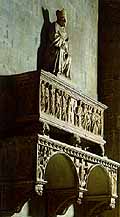
Tino di Camaino,
tomb of Bishop d'Orso
Over the centuries many masterpieces have been transferred to the Museum of the Opera del Duomo, among them the statues from the facade by Arnolfo, the Choir Lofts by Donatello and Luca della Robbia from the sacristies and the Pietà by Michelangelo; the Della Robbia lunettes in the sacristies, the tomb of Bishop Antonio d'Orso, the bust of Squarcialupi and the urn of St. Zanobus can still be admired in the interior of the Cathedral.
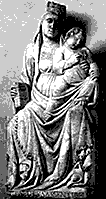
Tino di Camaino,
Madonna from the
tomb of d'Orso
The tomb of Bishop Orso, placed high on the inner facade, is one of the
most successful creations by the Sienese artist, Tino di Camaino, a follower
of Giovanni Pisano. Carried out in 1321, the monument is a solemn portrait
of the bishop, who was very popular with the Florentines for having defended
them during the seige laid on the city by the Emperor Henry VII (1312),
and praised by Dante as a liberator, in the time of the civil war between
the Black and White Guelphs.
The pose is unusual, for the prelate is shown in a seated but relaxed position,
with reclining head and closed eyes, like a dead man laid out on a throne. The
classically inspired sarcophagus resting on a large shelf supported by two arches
is placed below. Two parts of the monument were dismantled over the centuries
and are missing: some sculptures ended up in the Bargello, others were sold to
museums and collectors abroad. The bust of Antonio Squarcialupi, the work of
Benedetto da Maiano (1490) can be found a short distance away, along the left
hand nave. The famous organist is celebrated here in an epitaph written by Agnolo
Poliziano. The tomb of one of his ancestors, Niccolò Squarcialupi,
who died in 1313 and must have been an extremely important personage if his tomb
was placed in the main basilica of the city, was brought to light during the
excavation of Santa Reparata.

Ghiberti, the Urn of St. Zanobus
The centre chapel of the main apse contains the "Arca sepulcralis"
of St. Zanobus (bishop and also patron saint
of Florence with St. John the Baptist), who
died in 429, was first buried in San Lorenzo and then transferred
to the new cathedral in the 9th century.
In order to make sure that the work of art that was to contain his body would
be worthy of him, the commission was given to Lorenzo Ghiberti who, at the time,
was working on the Doors of Paradise for the Baptistery.
Once again the artist demonstrates his great talent as a sculptor and goldsmith:
the magnificent urn, cast in bronze, shows scenes from the life of the Saint,
following the usual Gothic style expedient of narrating different moments from
the same episode at the same time.
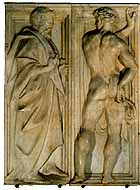
B. Bandinelli,
reliefs from the Chancel balustrade
The bas-reliefs and sculptures that once decorated the balustrade of the
chancel have all been transferred elsewhere (most of them to the Museum
of the Opera del Duomo). This large enclosure, carried out by Baccio
Bandinelli between 1547 and 1572 from a design by Giovanni di Baccio d'Agnolo
and dismantled in 1842, was one of the young Duke Cosimo
I de' Medici's contributions towards enriching the Cathedral;
its iconography reflected the new "political" rules of the Church,
the outcome of the Council of Trent, which were also glorified in the fresco
of the Last Judgement in the cupola.
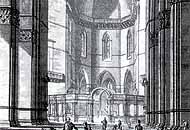
The ancient enclosure of the Chancel
In 1551 the Council Fathers had in fact issued a "decree on the Eucarist" that
confirmed the presence of the body and blood of Christ in the consacrated
Host; a year later, Bandinelli followed it up by placing his gigantic body
of Christ, held up by angels and surmounted by a statue of God the Father
(inspired by Michelangelo's Last Judgement
in the Sistine Chapel) over the high altar.
The statues of Adam and Eve were placed behind the altar in respect of the Council
of Trent's decrees on the original sin, formulated in 1546. These latter figures
are today in the Bargello, while the groups with Christ and God the Father are
in Santa Croce.
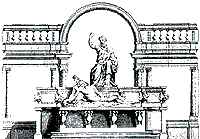
Bandinelli's group of scultures above the altar
The sculptures for the Door of the Canonici (the late 14th century work of Lorenzo di Giovanni d'Ambrogio and continued by Piero di Giovanni Tedesco) and above all those of the Door of the Mandorla (on the opposite northern side), can be admired on the exterior.
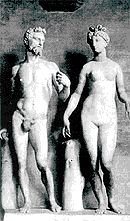
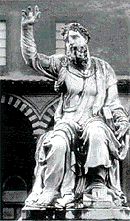
The statues by Bandinelli previously above the altar
Decorated in three phases between 1391 and 1422, the door represents an example of sculpture in Florence between the Gothic times and the Renaissance. It contains work by artists like Niccolò di Piero Lamberti from Arezzo, living in Florence from 1388 onwards, who created the unusual nude Venus inspired by Praxiteles, and Nanni di Banco, with his bas-relief masterpiece of the Assumption of the Virgin (1414-1422), which was carried out with the collaboration of young Donatello and Luca della Robbia.
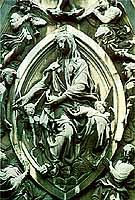
Nanni di Banco,
Our Lady of the Assumption
Donatello also carved some of the elements above
the door as well as the statuettes of the Prophets.
The centre mosaic of the Annunciation is by Domenico
Ghirlandaio (1491) and replaced a relief of
the same subject by Jacopo della Quercia (1404-1409).
This relief can now be seen in the Museum
of the Opera del Duomo.
